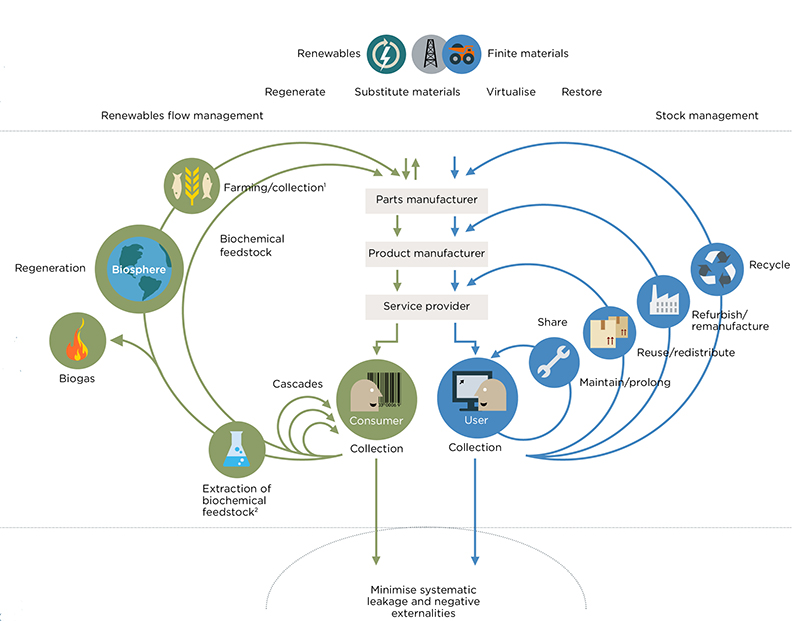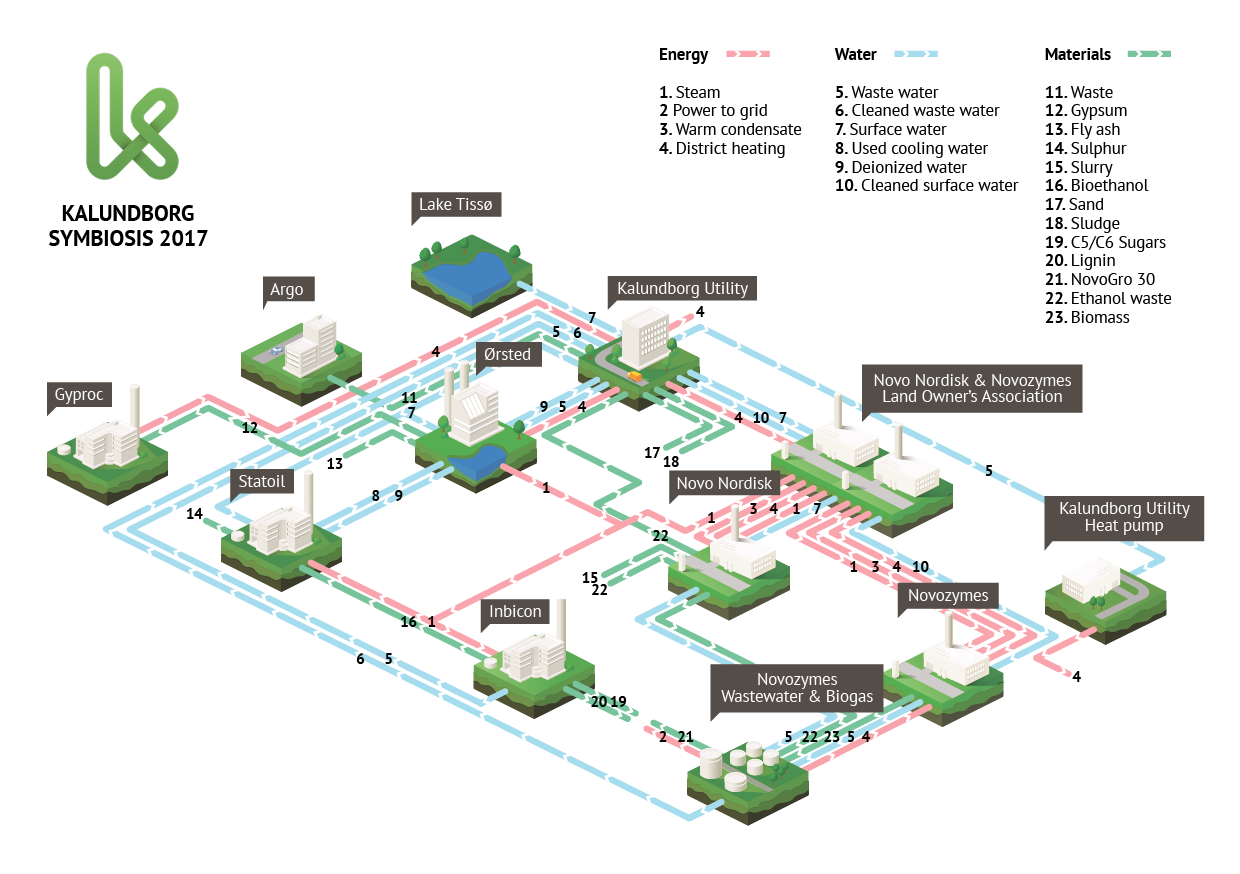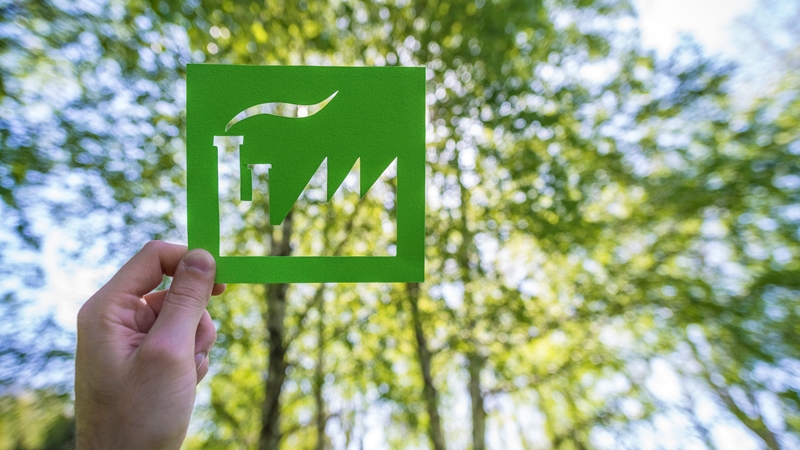Circular economy thinking is edging into industries across the board. But can it work for pharma too? Using two Danish industrial symbioses as examples, we demonstrate that it definitely can – but it requires a change in mindset and new ways of working together.
More and more pharma companies are placing sustainability at the top of the agenda and introducing various green or sustainable initiatives. But to drive true sustainable growth and innovation, pharma needs to embrace circular economy thinking.
What is circular economy thinking?
Let’s start with a short definition of the concept: A circular economy is based on the principles of designing out waste and pollution, keeping products and materials in use and regenerating natural systems. A circular economy seeks to rebuild capital, whether this is financial, manufactured, human, social or natural. This ensures enhanced flows of goods and services.

Source: Ellen MacArthur Foundation, SUN, and McKinsey Center for Business and Environment; Drawing from Braungart & McDonough, Cradle to Cradle (C2C)
Symbiosis is the more concrete manifestation of circular economy. The concept of “symbiosis” is usually associated with relationships in nature – thus called a natural symbiosis – where two or more species exchange materials, energy, or information in a mutually beneficial manner.
If you replace “species” with “companies” in the sentence above, you basically have an industrial symbiosis. The biggest potential for industrial symbiosis lies in bringing down the costs of raw, processed materials and waste through better use of existing technologies.
But is it even feasible that the pharma industry can go circular – when it is notorious (and rightly so to a large extent) for being rigidly regulated with limited opportunities to change resource consumption and, in turn, emissions? Sceptics may say that circular economy is not relevant for pharma and biotech.
There are, however, two Danish examples of symbiosis involving companies from the pharma industry who prove those sceptics wrong, both achieving great success and international recognition.
The Kalundborg symbiosis – the textbook example
Kalundborg Symbiose is a resource collaboration where one company’s residual streams or biproduct is used as a resource in another company’s production. The Kalundborg symbiosis cooperation has existed for more than 50 years, and today, more than 23 resource streams are shared among 12t private members. These are:
- Novo Nordisk (pharma
- Novozymes (enzymes)
- Equinor (refinery, formerly Statoil)
- Ørsted (thermal power plant)
- Gyproc Saint-Gobain (plasterboard)
- Kalundborg municipality
- Kalundborg Utility (water and heat provision, wastewater treatment)
- Argo (waste recycling station)
- Unibio
- BioPro
- Avista Green
- Kalundborg Bioenergi
Kalundborg Symbiose is therefore the world’s leading industrial symbiosis, and is often referred to as "The Kalundborg model".
These companies share resources in the form of energy, water and materials. For example, the energy layer includes steam, electricity and district heating, where one company’s excess heating becomes another company’s district heating. This also has a positive financial impact.
The water layer in the symbiosis contributes to water saving tanks for internal reuse and mutual exchange and uses inexpensive surface water from a nearby lake instead of expensive ground water.
In terms of materials, the companies exchange sulfur, plaster, sand and fly ash, reducing landfill for waste products. For example, one company has a sulfurous biproduct which another company uses in its production of plaster boards.

Source: www.symbiosecenter.dk (follow the link for an animated version of the flow of residual streams.)
A central element in the development of Kalundborg Symbiosis is the financial gains. A company that passes on residual streams or biproducts to another company usually has low or no expenses for waste treatment – and in some instances even an added earning. In turn, a company that collects residual streams or byproducts from others will have reduced resource costs for production.
Each resource stream in the symbiosis is thus established based on a financial rationale for participating companies. Due to common investments, for example, it is possible to obtain economies of scale and more effective utilization of resources. Several of the streams also contribute to environmental gains, for instance, such as lower CO2 emissions.
In recent years, The Kalundborg model has started to stretch beyond "just" the industrial symbiosis and is laying the foundation for Biotekbyen (biotech city) Kalundborg, an expanded symbiosis involving social and economic efforts and activities.
The vision is that Biotekbyen Kalundborg will become the Silicon Valley of biotech production in Scandinavia and the center for education and knowledge within biotech production and process technology. In 2015, Symbiosis Center Denmark was formed in Kalundborg. The center – the first symbiosis in the world – works to identify and facilitate new industrial symbioses in Denmark.
In 2018, the Kalundborg Symbiosis was awarded the Win-Win Gothenburg Sustainability Award (virtually the Nobel prize of sustainability). The Gothenburg Award for Sustainable Development is given each year to people or organizations for outstanding performance and achievements towards a sustainable future. Previous winners of the award include Kofi Annan and Al Gore.
The Hillerød symbiosis – a triple symbiosis
In 2013, different players in Hillerød initiated the creation of an industrial symbiosis based on an objective to drive sustainable innovation and growth across the local industry and community. But in 2014, the members quickly realized that a broader approach was needed to ensure success. At the same time, it was acknowledged that new thinking and innovation to create sustainable growth requires not only a broader perspective but also a range of different collaborators from research, authorities, companies and citizens. This new realization formed the foundation for Symbiosis Hillerød.
The members of Symbiosis Hillerød include, among others:
- Fujifilm Diosynth Biotechnologies (pharma)
- Novo Nordisk (pharma)
- C4 Videncenter
- Hillerød Utility (water and heat provision, wastewater treatment)
- Nordsjællands Hospital
Hillerød Utility and Nordsjælland Hospital have established a “partnership”, where food waste from the hospital is transformed to biogas which is used as fuel for district heating in Hillerød.
In addition, Fujifilm, Novo Nordisk and Hillerød Utility have joined forces to establish a 2.5 kilometers wastewater pipe which runs across the two pharma companies’ green areas to the treatment plant, allowing them to hook onto the pipe. Because the pipe is so big, there is enough calcium in the water to neutralize the acidic wastewater from the pharma plants. This means that Novo Nordisk and Fujifilm do not have to use chemicals to neutralize their wastewater, rendering both financial and environmental benefits.
Aside from the traditional technical aspects of symbiotic relations, Symbiosis Hillerød also has social, environmental and natural aspects at the center of their cooperation. In many ways, Symbiosis Hillerød is a network and not only a resource symbiosis.
Industrial symbioses create benefits on all levels
It’s clear from the cases above that there are many benefits to industrial symbiosis – both on a company level, on a local level and on a broader socio-economic level.
Both Kalundborg Symbiosis and Symbiosis Hillerød include both small and world-leading companies, and all of them – regardless of size – experience benefits, such as:
- Lower costs for raw materials and waste handling
- Improved competitiveness
- Higher robustness against market fluctuations
- Reduced consumption of natural resources
- Lower emission of CO2
In terms of benefits for both the local community and broader society, there is much to be gained from industrial symbiosis and circular economy. Calculations from the Ellen MacArthur Foundation show that in Denmark (a small country with a population of around 5.8 million), circular economy could create 10,000 new jobs and generate a 1.4 % increase in GNP. The annual socio-economic contribution from Kalundborg Symbiose has been calculated to DKK 106 million[1]. Moreover, between 2010 and 2015, Kalundborg saw a rise in the number of industrial jobs, while there was a general decline in the number of industrial jobs in the rest of the country[2].
Community before the individual
So, what does it take for pharma to go circular? First and foremost, it requires that company decision-makers recognize the potential gains of the symbiosis. And secondly, that they are able to establish a collaboration with another company. Indeed, this may be the biggest obstacle, as it requires an entirely new mindset.
As Jofrid Klokkehaug from Equinor (Kalundborg Symbiosis) puts it: “The physical distance is not the biggest obstacle for the symbiosis. It’s the mental distance.”
An industrial symbiosis is not about doing business. The intent is not to create a supplier-customer relation between parties. It’s about finding common solutions to common challenges, which means companies must be open about their individual challenges. Good and open discussion and trust-based cooperation are at the core of both the Kalundborg symbiosis and Symbiosis Hillerød.
Martin Damm, Mayor of Kalundborg Municipality, confirms this: “The success depends on the companies’ willingness to open the books to each other and engage in discussions that they would not normally do.”
In Symbiosis Hillerød, the members also talk about joint solutions to challenges concerning wastewater, infrastructure, workforce and education. Thanks to the symbiosis, the companies can form a united front, which makes it is easier to do something about those challenges. This also means that success is not (only) measured on individual company level, but on a broader scale.
As an example, the DKK 50 million that Novo Nordisk saves every year because of the Kalundborg symbiosis is a vanishingly small part of the company’s DKK 113 billion turnover. But that’s not the focus, as Michael Hallgreen from Novo Nordisk points out: “If we look at it matter-of-factly, our business would do fine without the symbiosis (…). Another way to look at it is that it attracts new companies to the area.”[3].
Likewise, Birgitte Thygesen, Director at Biogen says: “We all have to contribute if we want to drive sustainable, green growth for local business and community. It’s about cooperation and knowledge-sharing. At Biogen, we are happy to contribute with what we can and to learn from the experience of others.”[4]
In conclusion, the mission for any symbiosis should be to think beyond your own operations - and to think community before the individual. This mind-set has enabled huge pharma companies like Fujifilm FUJIFILM Diosynth Biotechnologies and Novo Nordisk to work together to drive growth and innovation.
[3] https://www.altinget.dk/artikel/den-cirkulaere-oekonomi-blev-foedt-i-en-vestsjaellandsk-provinsby
[4] http://www.e-pages.dk/erhvervnordsjaelland/21/


